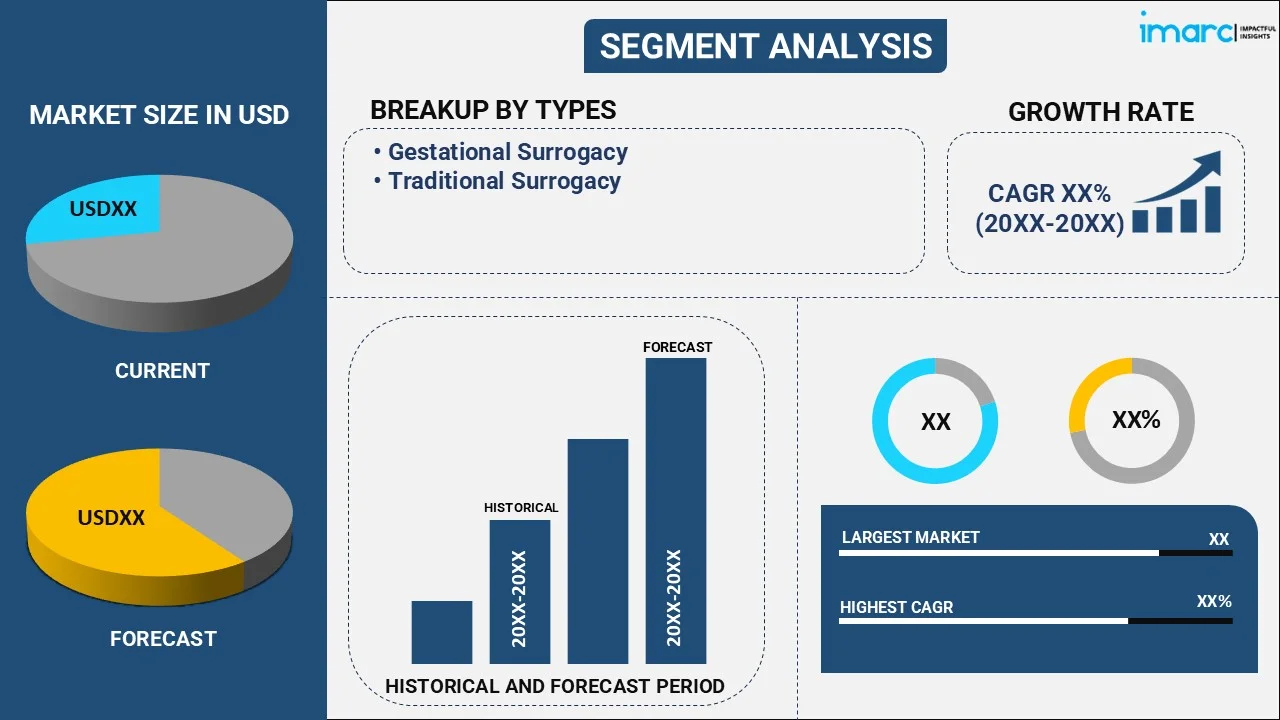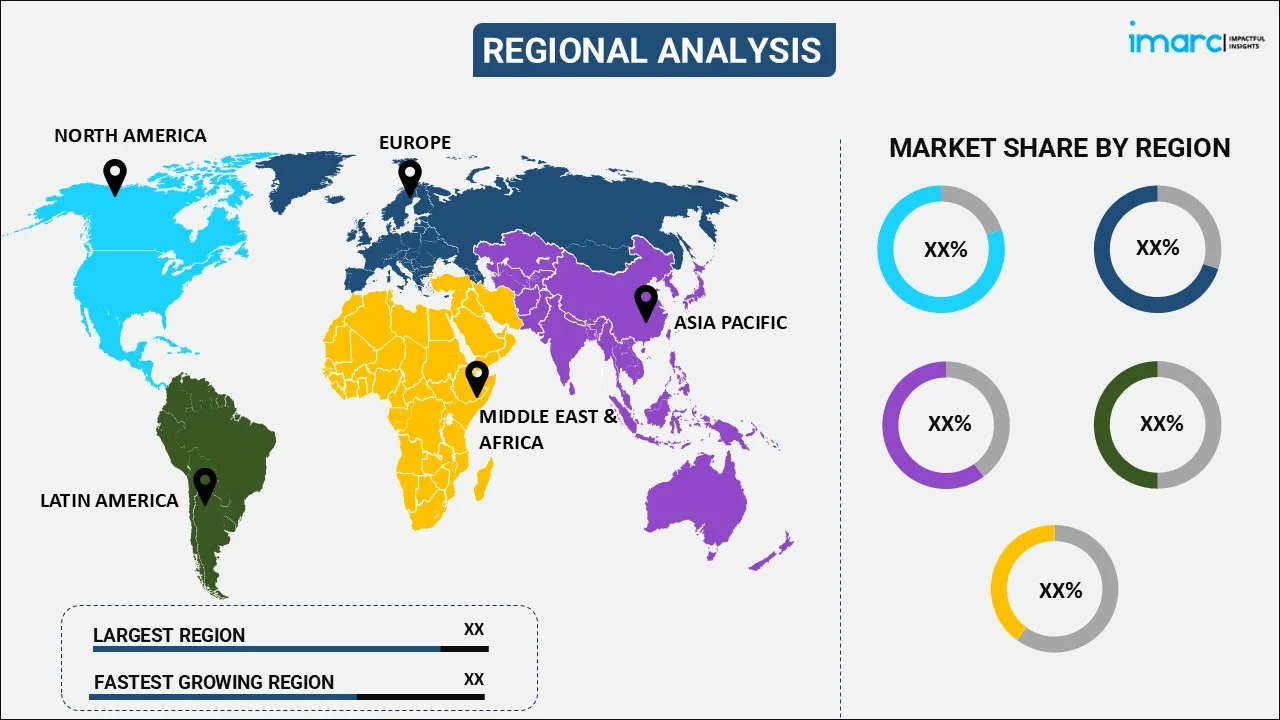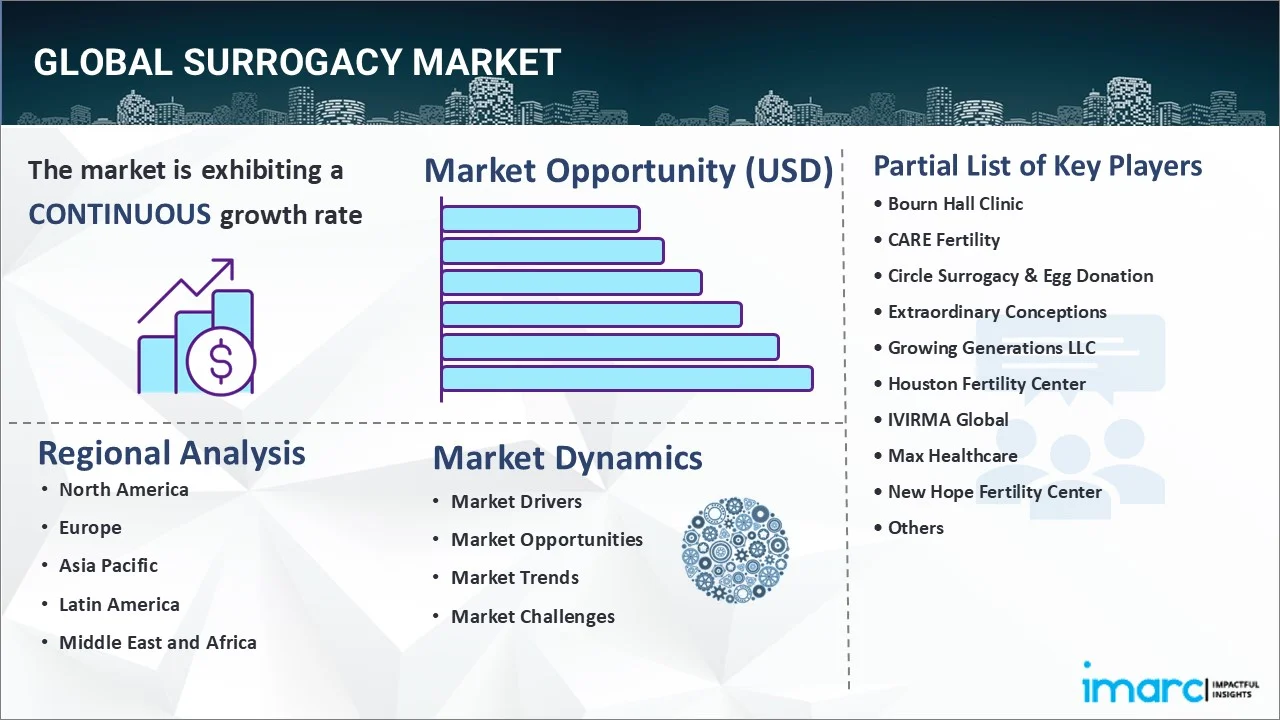
Surrogacy Market Report by Type (Gestational Surrogacy, Traditional Surrogacy), Technology (IVF with ICSI, IVF without ICSI, Intrauterine Insemination), Service Provider (Hospitals, Fertility Clinics, and Others), and Region 2025-2033
Market Overview:
The global surrogacy market size reached USD 194.0 Million in 2024. Looking forward, IMARC Group expects the market to reach USD 321.4 Million by 2033, exhibiting a growth rate (CAGR) of 5.48% during 2025-2033. The rapid growth of fertility tourism, increasing prevalence of infertility, the availability of convenient and inexpensive surrogacy, and the implementation of favourable payment policies by the governing authorities of many countries represent some of the key factors driving the growth of the market.
|
Report Attribute
|
Key Statistics
|
|---|---|
|
Base Year
|
2024
|
|
Forecast Years
|
2025-2033
|
|
Historical Years
|
2019-2024
|
|
Market Size in 2024
|
USD 194.0 Million |
|
Market Forecast in 2033
|
USD 321.4 Million |
| Market Growth Rate (2025-2033) | 5.48% |
Global Surrogacy Market Analysis:
- Major Market Drivers: The surrogacy market is mainly fueled by the growing incidence of infertility and the increasing awareness and societal acceptance of surrogacy as a viable option. Legal developments in a number of countries, which create transparent rules and safeguards for all participants, play a key role in market expansion. Improvements in medical innovations that enhance the success rates of IVF treatments also increase the need for surrogacy. In addition, the increasing recognition of LGBTQ+ rights and the demand from homosexual couples to have organic children are vital. Economic considerations, with surrogacy services being provided at cheaper rates in some areas, also act as the market driver.
- Key Market Trends: The surrogacy market is growing due to the increasing infertility rates and the growing acceptance of nontraditional family forms. The tendency is to move towards gestational surrogacy, which stands out by its genetic distance between the surrogate and the child. Innovations in Assisted Reproductive Technologies (ART) are improving success rates, making the demand even higher. In addition, legal changes in different countries are eliminating the legislative uncertainty that surrounds surrogacy, which makes it quite available. Seafaring surrogacy is also increasing due to legal and cost differences among countries. Nevertheless, ethical considerations and regulatory variations present the global surrogacy market with challenges.
- Competitive Landscape: Some of the major market players in the global surrogacy market include Bourn Hall Clinic, CARE Fertility, Circle Surrogacy & Egg Donation, Extraordinary Conceptions, Growing Generations LLC, Houston Fertility Center, IVIRMA Global, Max Healthcare, New Hope Fertility Center, Nova IVF, Ovation Fertility, Scanfert Clinic, etc.
- Geographical Trends: The most significant market for surrogacy is North America, largely benefiting from the relatively vacant legal environment. The legal framework of many countries is clear and supportive enough to protect the rights of the intended parents, surrogates, and the resultant children. Legal certainty of this type attracts not only domestic but also international intended parents who are looking for surrogacy services that are easily enforceable and reliable. Moreover, America provides highly developed fertility treatment medical centers and assures success rates and safety profiles of surrogacy procedures. This together with rather high public acceptance of surrogacy, makes North America the main market in the world’s surrogacy scene.
- Challenges and Opportunities: Surrogacy raises issues of exploitation, especially in areas where there are fewer regulations and, if not well planned, could lead to emotional, legal, and financial abstractions for all the parties involved. Legally, laws in different countries can complicate custody and parental rights issues. Nevertheless, surrogacy presents significant opportunities especially to people who cannot conceive naturally, such as same-sex couples and people with medical infertility. The advances in reproductive technology have improved safety and effectiveness of the process and expanded family-building options.
Surrogacy Market Trends/Drivers:
Legal Framework and Support
The legal environment significantly affects the market for surrogacy. The jurisdiction with clear and supportive legislations eliminates the unnecessary risks associated with surrogacy for all the parties involved and creates a safe and trusted process which also suits the surrogates. For instance, gestational surrogacy accounts for approximately 90% of all surrogacy arrangements. The success rate for gestational surrogacy is around 75%. Such legal support guarantees the rights protection and defines parental custodies thus appealing to a wider intended parents demographic.
Advancements in Reproductive Technologies
The innovations that were made in the area of reproductive medicine have made surrogacy safer and more efficient. The probability and success rate of pregnancy are increased by innovations such as IVF, genetic screening, and embryo transfer techniques, hence making surrogacy attractive to those who wish to start or grow their families. For instance, the pregnancy success rate per embryo transfer in gestational surrogacy ranges from 30% to 60%. The success rates may be higher when using younger and healthy surrogates. Approximately 2% of babies born in the United States were conceived using assisted reproductive technology. Success rates vary but are closely correlated with the quality of the eggs and embryos. PGT- tested embryos have a live birth rate of 75-80%.
Societal Acceptance and Changing Norms
The growth of the surrogacy market is driven by the growing societal acceptance of different family forms, including those formed through surrogacy. With the reduction of cultural and social barriers, surrogacy is becoming a more acceptable option in modern society. For instance, a study found that 54.8% of medical students and 52.9% of lawyers surveyed in Lebanon were supportive of surrogacy. Such shift is based on the increasing level of awareness and understanding in surrogacy practices.
Surrogacy Industry Segmentation:
IMARC Group provides an analysis of the key trends in each segment of the global surrogacy market report, along with forecasts at the global, regional and country levels from 2025-2033. Our report has categorized the market based on type, technology, and service provider.
Breakup by Type:

- Gestational Surrogacy
- Traditional Surrogacy
Gestational surrogacy dominates the market
The report has provided a detailed breakup and analysis of the market based on the type. This includes gestational surrogacy and traditional surrogacy. According to the report, gestational surrogacy represented the largest segment.
Gestational surrogacy method involves the surrogate carrying the pregnancy that is conceived from the eggs and sperm of the intended parents or donors. It offers unique benefits, such as reducing the genetic connection between the surrogate and the offspring, thus solving legal and psychological challenges. Gestational surrogacy also provides an opportunity for individuals and couples with reproductive issues, same-sex couples, and people interested in genetic diversity. Additionally, the improvements in accuracy of assisted reproductive technologies, namely in vitro fertilization (IVF), are driving up the success rates of gestational surrogacy.
Breakup by Technology:
- IVF with ICSI
- IVF without ICSI
- Intrauterine Insemination
IVF with ICSI holds the largest share in the market
A detailed breakup and analysis of the market based on the technology has also been provided in the report. This includes IVF with ICSI, IVF without ICSI, and intrauterine insemination. According to the report, IVF with ICSI accounted for the largest market share.
In vitro fertilization (IVF) with intracytoplasmic sperm injection (ICSI) is a sophisticated approach to assisted reproductive technology that overcomes male infertility issues by injection of a single sperm directly into an egg, resulting in maximized fertilization. IVF combined with ICSI allows intended parents to deal with the complicated fertility problems, so surrogacy services become available to more clients. Additionally, the high success rates linked with this procedure also lead intended parents to regard surrogacy as a reliable avenue to happiness and as such, these success rates only make the demand for surrogacy services to thrive. The interconnection of IVF with ICSI increases the medical applicability of surrogacy and adds forces to its reputation as an efficacious instrument in the market development.
Breakup by Service Provider:
- Hospitals
- Fertility Clinics
- Others
Fertility Clinics represent the most popular service provider
The report has provided a detailed breakup and analysis of the market based on the service provider. This includes hospitals, fertility clinics, and others. According to the report, fertility clinics represented the largest segment.
Fertility clinics are a key driver in stimulating the market growth by providing necessary medical knowledge and facilities. These clinics provide a variety of advanced reproductive technologies, including in vitro fertilization (IVF) and embryo transfer procedures, which are basic methods for surrogacy. The fertility clinics offer full medical assessments, detailed treatment plans, and constant surveillance over the whole surrogacy process, thereby providing the very best results. Moreover, fertility clinics work closely with surrogacy agencies and legal experts, thus, providing a smooth process for intended parents and surrogates. Fertility clinics facilitate the market growth as they are the centers of medical innovation and support that make the successful pregnancies possible, facilitate family expansion, and nurture intended parents and surrogates’ partnerships.
Breakup by Region:

- North America
- United States
- Canada
- Asia-Pacific
- China
- Japan
- India
- South Korea
- Australia
- Indonesia
- Others
- Europe
- Germany
- France
- United Kingdom
- Italy
- Spain
- Russia
- Others
- Latin America
- Brazil
- Mexico
- Others
- Middle East and Africa
North America exhibits a clear dominance in the market
The report has also provided a comprehensive analysis of all the major regional markets, which include North America (the United States and Canada); Asia Pacific (China, Japan, India, South Korea, Australia, Indonesia, and others); Europe (Germany, France, the United Kingdom, Italy, Spain, Russia, and others); Latin America (Brazil, Mexico, and others); and the Middle East and Africa. According to the report, North America accounted for the largest market share.
The lead in the surrogate market was taken by North America because of its good legal, medical, and social environment. The robust regulations in the region in countries, such as the United States and Canada, ensure the safety of intended parents and surrogates. The advanced medical facilities and the competence of the medical personnel in the field of assisted reproductive technologies, in combination with a tolerant social setting in North America, attract both domestic and international individuals and couples desiring surrogacy services. Furthermore, the multi-ethnic population of the region and changes in the perception of the family have promoted surrogacy.
Competitive Landscape:
Major surrogacy agencies are adopting the digital age and improving the communication between intended parents, surrogates, and medical professionals. They are incorporating new techniques in advanced embryo screening, this will improve the success rates and reduce the chances of genetic disorders. Some significant players are experimenting with eco-friendly approaches through implementing sustainability in fertility treatment. There are more associations with fertility clinics and legal professionals who aid in following changing regulations. All these innovations together represent the assertion of key players to provide progress as to the surrogacy experience in technology and medicine.
The report has provided a comprehensive analysis of the competitive landscape in the market. Detailed profiles of all major companies have also been provided. Some of the key players in the market include:
- Bourn Hall Clinic
- CARE Fertility
- Circle Surrogacy & Egg Donation
- Extraordinary Conceptions
- Growing Generations LLC
- Houston Fertility Center
- IVIRMA Global
- Max Healthcare
- New Hope Fertility Center
- Nova IVF
- Ovation Fertility
- Scanfert Clinic
(Kindly note that this only represents a partial list of companies, and the complete list has been provided in the report.)
Recent Developments:
- In June 2021, Circle Surrogacy & Egg Donation sponsored A Lifetime of Pride and Joy, a campaign that celebrates and encourages family equality by raising awareness around the accessibility of fertility care among the LGBTQ+ population. This impactful campaign is dedicated to the celebration and advancement of family equality, while also shedding light on the crucial aspect of accessible fertility care. By participating in this campaign, Circle Surrogacy takes a resolute stance in promoting inclusivity and understanding, embracing the diversity of modern families.
- In June 2023, AHH's Nova IVF Fertility, a pioneering name in the realm of assisted reproductive healthcare, unveiled an ambitious roadmap that envisages the establishment of an impressive network of 100 centers within the next four years. This strategic expansion plan, as reported by the Economic Times, reflects the organization's unwavering commitment to providing accessible and advanced fertility care across India.
- In October 2022, Ovation Fertility, a leading name in the field of assisted reproductive technology, unveiled an exciting and transformative partnership with Genomic Prediction. This collaboration marks a significant milestone in the realm of genetic testing, as it promises to not only enhance but also expand the horizons of genetic assessment within the domain of fertility and family planning. The alliance between Ovation® Fertility and Genomic Prediction showcases a shared commitment to leveraging cutting-edge scientific advancements to empower intended parents with a deeper understanding of their genetic profile and reproductive options.
Surrogacy Market Report Scope:
| Report Features | Details |
|---|---|
| Base Year of the Analysis | 2024 |
| Historical Period | 2019-2024 |
| Forecast Period | 2025-2033 |
| Units | Million USD |
| Scope of the Report | Exploration of Historical and Forecast Trends, Industry Catalysts and Challenges, Segment-Wise Historical and Predictive Market Assessment:
|
| Types Covered | Gestational Surrogacy, Traditional Surrogacy |
| Technologies Covered | IVF with ICSI, IVF without ICSI, Intrauterine Insemination |
| Service Providers Covered | Hospitals, Fertility Clinics, Others |
| Regions Covered | Asia Pacific, Europe, North America, Latin America, Middle East and Africa |
| Countries Covered | United States, Canada, Germany, France, United Kingdom, Italy, Spain, Russia, China, Japan, India, South Korea, Australia, Indonesia, Brazil, Mexico |
| Companies Covered | Bourn Hall Clinic, CARE Fertility, Circle Surrogacy & Egg Donation, Extraordinary Conceptions, Growing Generations LLC, Houston Fertility Center, IVIRMA Global, Max Healthcare, New Hope Fertility Center, Nova IVF, Ovation Fertility, Scanfert Clinic etc. |
| Customization Scope | 10% Free Customization |
| Post-Sale Analyst Support | 10-12 Weeks |
| Delivery Format | PDF and Excel through Email (We can also provide the editable version of the report in PPT/Word format on special request) |
Key Benefits for Stakeholders:
- IMARC’s report offers a comprehensive quantitative analysis of various market segments, historical and current market trends, market forecasts, and dynamics of the surrogacy market from 2019-2033.
- The research study provides the latest information on the market drivers, challenges, and opportunities in the global surrogacy market.
- The study maps the leading, as well as the fastest-growing, regional markets. It further enables stakeholders to identify the key country-level markets within each region.
- Porter's five forces analysis assist stakeholders in assessing the impact of new entrants, competitive rivalry, supplier power, buyer power, and the threat of substitution. It helps stakeholders to analyze the level of competition within the surrogacy industry and its attractiveness.
- Competitive landscape allows stakeholders to understand their competitive environment and provides an insight into the current positions of key players in the market.
Key Questions Answered in This Report
The global surrogacy market was valued at USD 194.0 Million in 2024.
We expect the global surrogacy market to exhibit a CAGR of 5.48% during 2025-2033.
The increasing awareness towards infertility treatments, including sperm or egg donation and In-Vitro Fertilization (IVF), along with the rising utilization of gestational surrogacy by surrogacy professionals for less complications, is primarily driving the global surrogacy market.
The sudden outbreak of the COVID-19 pandemic had led to postponement of surrogacy treatment to reduce the risk of coronavirus infection upon hospital visits or interaction with medical equipment, thereby negatively impacting the demand for surrogacy treatments.
Based on the type, the global surrogacy market can be categorized into gestational surrogacy and traditional surrogacy. Currently, gestational surrogacy exhibits clear dominance in the market.
Based on the technology, the global surrogacy market has been segmented into IVF with ICSI, IVF without ICSI, and intrauterine insemination. Among these, IVF with ICSI technology represents the largest market share.
Based on the service provider, the global surrogacy market can be bifurcated into hospitals, fertility clinics, and others. Currently, fertility clinics account for the majority of the total market share.
On a regional level, the market has been classified into North America, Europe, Asia-Pacific, Middle East and Africa, and Latin America, where North America currently dominates the global market.
Some of the major players in the global surrogacy market include Bourn Hall Clinic, CARE Fertility, Circle Surrogacy & Egg Donation, Extraordinary Conceptions, Growing Generations LLC, Houston Fertility Center, IVIRMA Global, Max Healthcare, New Hope Fertility Center, Nova IVF, Ovation Fertility, and Scanfert Clinic.
Need more help?
- Speak to our experienced analysts for insights on the current market scenarios.
- Include additional segments and countries to customize the report as per your requirement.
- Gain an unparalleled competitive advantage in your domain by understanding how to utilize the report and positively impacting your operations and revenue.
- For further assistance, please connect with our analysts.

 Inquire Before Buying
Inquire Before Buying
 Speak to an Analyst
Speak to an Analyst
 Request Brochure
Request Brochure
 Request Customization
Request Customization




.webp)




.webp)












